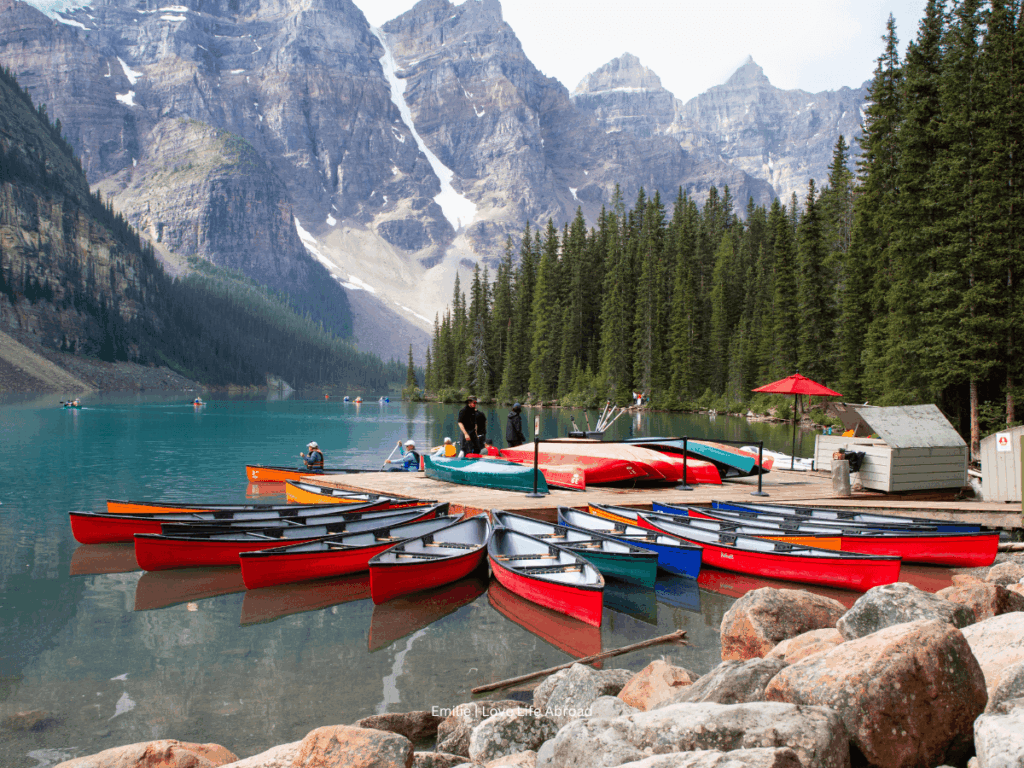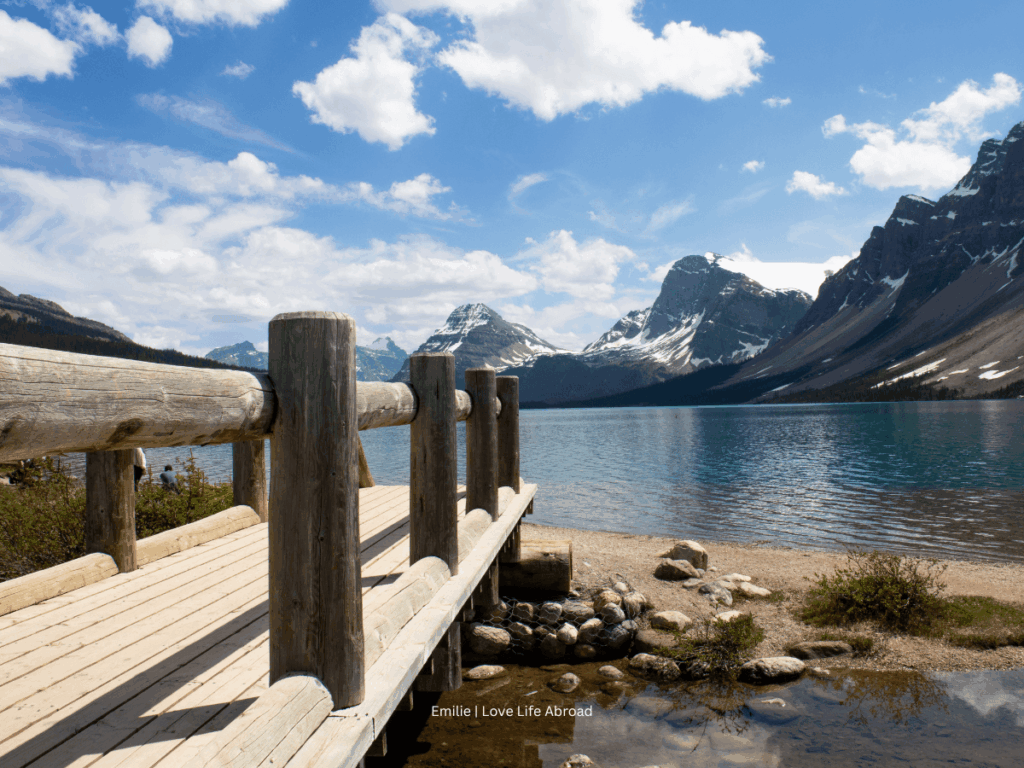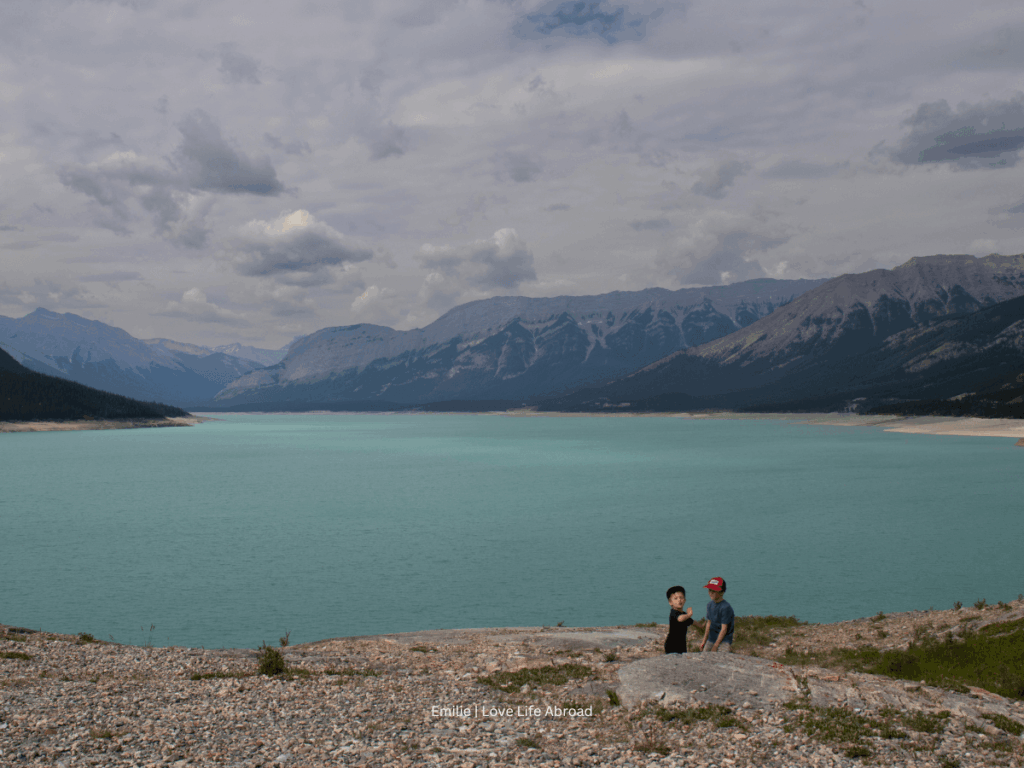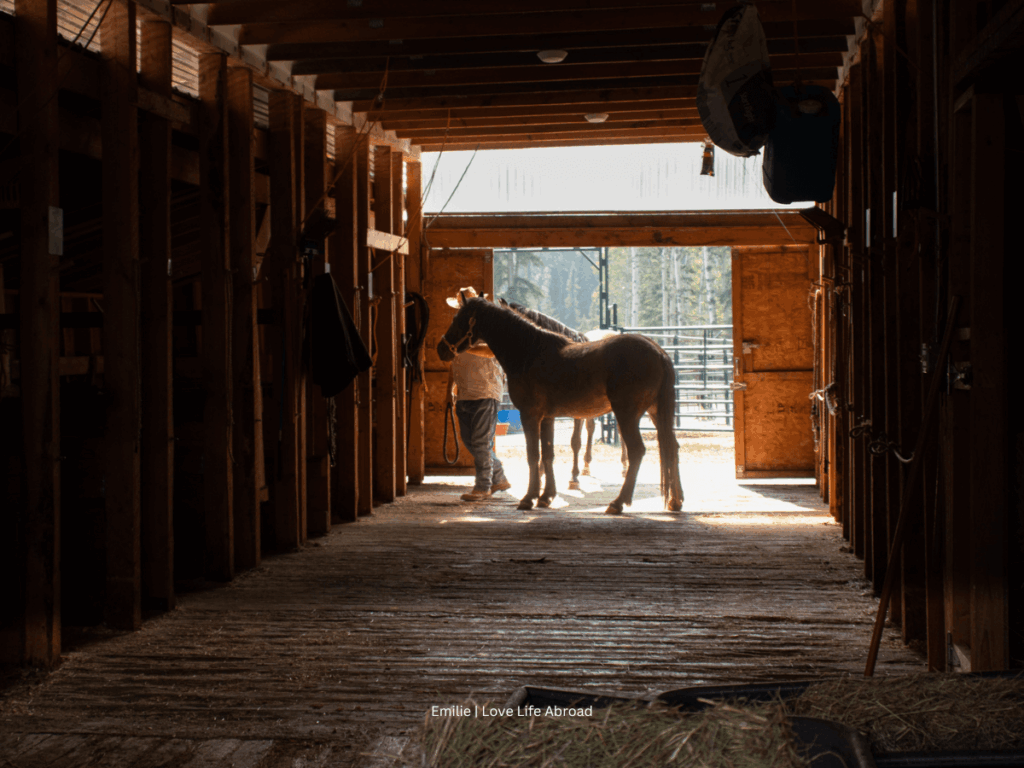Alberta Road Trip Itinerary on the David Thompson Highway
Looking for a new way to explore the Canadian Rockies without the summer crowds? This Alberta road trip along the David Thompson Highway takes you through some of the most scenic and lesser-known parts of the Eastern Canadian Rockies. It’s a route filled with waterfalls, glacier views, quiet mountain towns, and family-friendly hikes.
Banff and Jasper are often the first stops for visitors, and they’re beautiful. But if you have a few extra days, this loop adds a fresh side of Alberta many travellers miss. From iconic lakes to quiet trails near Nordegg and Rocky Mountain House, you’ll get a true mix of adventure and relaxation.
We’ve driven this route as a family and gathered the best stops, hikes, and activities that work well with kids. You’ll find small towns, local treats, and easy detours worth your time. This itinerary gives you a flexible plan for 5 to 7 days through some of Alberta’s most rewarding landscapes.
Disclaimer: Just a heads up, this free article contains affiliate links. If you purchase after clicking one of these links, I may earn a small commission at no additional cost. Your support helps me continue to provide helpful and free content for you.
Stop 1: Banff (2 to 3 Days)

We always recommend spending at least two or three days in Banff. It’s one of the most scenic towns in Canada, and there’s a lot to do without needing to rush. Banff is a great place to ease into your Alberta road trip.
It also works well for families, offering easy trails, playgrounds, and a variety of kid-friendly food options.
Day 1: Explore Downtown Banff and Nearby Walks
Start by exploring downtown Banff. Banff Avenue is the main street and perfect for a stroll, especially with kids. You’ll find shops, local restaurants, and fun stops like the Spirit of Christmas, where you can pick up a unique ornament to remember your trip. Grab an ice cream at Cows Banff, or stop by the candy shop for a treat.
Just a short walk from the main street is Central Park, where kids can play on a natural playground and adults can relax by the river. Right next to the park is the Banff Park Museum. It’s small but interesting, with preserved animals and historical exhibits. It’s also free with your Parks Canada Discovery Pass.
In the afternoon, walk along the Bow River Trail. It’s an easy, flat path with nice views and lots of space for kids to run. Continue along the trail until you reach Bow Falls, a wide, powerful waterfall close to town. From the Bow Falls parking lot, walk up the staircase to reach Waldhaus Restaurant, tucked into the trees above the river. It’s a cozy spot for lunch or dinner.
Day 2: Lake Louise and Moraine Lake
Set aside a full day to explore Lake Louise and Moraine Lake. Both lakes are among the most iconic spots in the Canadian Rockies. To visit, you’ll need to reserve shuttle bus tickets in advance, as personal vehicles are not allowed during the peak season. You can also book a private tour if the Parks Canada shuttle is full.
Start at Moraine Lake with the short Rockpile Trail hike. It’s where you’ll get the famous Moraine Lake view (turquoise water and surrounding peaks). It’s a short climb, but very manageable with kids. After that, head to Lake Louise and walk along the Lakeshore Trail, a flat path with amazing views. You can also bring a picnic to enjoy by the lake or grab lunch from the café inside the Fairmont.
This day is more about soaking up the views than rushing through stops. Take your time and enjoy the calm mountain setting.
Day 3: Cave & Basin, Hiking or Sunshine Meadows
If you have a third day in Banff, start with a visit to the Cave and Basin National Historic Site. This is the birthplace of Canada’s national parks system. The site includes warm mineral springs, an interpretive centre, and a short boardwalk trail.
If available, book a guided visit (offered in English or French). They’re great for learning the history of the site and the wildlife that lives in the area.
After that, choose between a hike or a gondola ride. For a hike, Johnston Canyon is a favourite for families. The trail is well-maintained, with catwalks leading through the canyon and two sets of waterfalls. Go early to beat the crowds, and don’t miss the Upper Falls, which are worth the extra distance.
If you prefer something easier (but truly amazing), take the gondola at Sunshine Village to explore Sunshine Meadows. At the top, the Rock Isle Trail is a great family hike with wide trails, mountain views, and alpine lakes. It’s peaceful, less crowded, and very scenic.
🛏️ Where to stay in Banff:
- Banff Rocky Mountain Resort – Spacious suites with kitchens
- Moose Hotel & Suites – Central location, rooftop hot pools
- Fairmont Banff Springs – If you want a bit of luxury and iconic views
Driving the Icefields Parkway (Banff to Saskatchewan Crossing)

The Icefields Parkway is one of the most scenic drives in Alberta (and in the world). It runs between Lake Louise and Jasper, cutting through the heart of the Canadian Rockies.
For this itinerary, we recommend driving the southern portion, from Banff to Saskatchewan Crossing, as part of your loop toward the David Thompson Highway. It’s only about 80 km, but you’ll want to plan several stops along the way.
Recommended Stops Along the Parkway:
Bow Lake: One of the first major stops, Bow Lake is calm, quiet, and beautiful. You can walk along the lakeshore or stop for a short picnic. The water here comes from the Bow Glacier, and on a still day, you’ll see reflections of the surrounding peaks in the lake.
Peyto Lake: Just a few minutes further is the Peyto Lake viewpoint. A short, paved trail brings you to an upper platform with a famous view of the bright blue, wolf-shaped lake below.
Mistaya Canyon: This is a great place to stretch your legs. The Mistaya Canyon Trail is a 1.1 km loop, to walk out to the canyon waterfall and back. You’ll cross a small bridge and get a close-up look at the deep canyon carved by the rushing water.
Weeping Wall Viewpoint: This is a quick stop where snowmelt flows down a tall cliff, creating a series of small waterfalls. It’s just a viewpoint off the highway, but it’s fun for kids to see and a good spot to break up the drive.
Parker Ridge Trail: If you’re up for something a bit more challenging, the Parker Ridge Trail is a 6.6 km round-trip hike with 345 metres of elevation gain. It has steady switchbacks and open views, and the reward is a beautiful lookout over the Saskatchewan Glacier.
** This is best for families with older kids or those used to hiking, but it’s not too difficult if you take your time.
By late afternoon or early evening, you’ll arrive at Saskatchewan Crossing, where you can stay the night. It’s a good stopping point before turning off the Icefields Parkway and continuing your trip along the quieter David Thompson Highway.
🛏️ Where to Stay:
We recommend The Crossing Resort for its convenience and location. There’s an on-site restaurant and basic amenities, making it a solid option for an overnight stay before the next leg of your trip.
Saskatchewan Crossing to Rocky Mountain House (via David Thompson Highway)

After a night at Saskatchewan Crossing, it’s time to turn east onto Highway 11, also known as the David Thompson Highway. This stretch is quieter than the Icefields Parkway, but just as stunning in places, especially around Abraham Lake and Nordegg.
You’ll see rugged peaks, turquoise rivers, and open mountain views without the crowds. This is where the Eastern Canadian Rockies really shine.
Cline River & Abraham Lake
Soon after leaving Saskatchewan Crossing, you’ll pass through the small area of Cline River. From here, plan a stop at Whitegoat Falls, a lesser-known trail that leads to a beautiful two-tiered waterfall.
The trailhead is at the Cline Transfer Station (search for “Vision Quest” in your GPS). The hike is about 3.1 km out and back. It’s not always well-marked, but if you’re unsure, you can book a guided tour with Nordegg Adventures (bonus: they include snacks and even popsicles, which our kids loved).
Another easy option is Crescent Falls, a short 1.8 km trail leading to a powerful waterfall with viewpoints along the canyon edge. It’s a popular local spot and doesn’t take long to explore.
As you continue along Abraham Lake, make sure to stop for a few photos. The lake is known for its bright blue water and, in winter, for the frozen methane bubbles trapped under the surface. Even in summer, it’s worth pulling over to enjoy the view.
Nordegg
Next, make your way to Nordegg, a small town that feels tucked away in time. It’s located at the base of the Rockies and surrounded by forest and open land. Stop for a snack or light meal at the Nordegg Canteen, where you can get a homemade popsicle or a cup of coffee. Then, visit Miner’s Café for their well-loved cinnamon twists.
If you have time, take a guided tour of the Brazeau Collieries Mine. It’s a historic coal mine that played a significant role in the development of this region. With younger kids, we recommend the shorter 1.5-hour version of the tour. You’ll walk through old buildings, learn about mining life, and hear stories from a different era.
Depending on how your day goes, you can choose to spend the night in Nordegg or continue on to Rocky Mountain House, which is about a 1.5-hour drive from town. In Rocky Mountain House, you can book one of the Parks Canada Heritage cabins and tents, which are perfect for a night of comfy, rustic camping without needing all the gear.
Rocky Mountain House to Calgary (with stops in Sundre and Cochrane)

From Rocky Mountain House, it’s time to head back toward Calgary. This final stretch of your Alberta road trip follows part of the Cowboy Trail, with plenty of chances to stop, stretch your legs, and enjoy a few more unique spots along the way.
Rocky Mountain House National Historic Site
Before you hit the road, plan a morning visit to the Rocky Mountain House National Historic Site. This is a great family-friendly stop where kids can pick up an Xplorer booklet and explore the region’s fur trade history. The site has walking paths, a small interpretive centre, and lots of open space to enjoy before the drive.
Sundre
Your first stop is the town of Sundre, about 1.5 hours from Rocky Mountain House. It’s a small, welcoming place with a few great attractions.
At the Sundre & District Pioneer Village Museum, you can step back in time and visit original buildings from the early 1900s, including a schoolhouse, ranger cabin, and blacksmith shop. The outdoor village has over eight restored heritage buildings set on four acres of land.
Inside the main museum building, don’t miss the World of Wildlife exhibit, featuring more than 170 animal mounts from around the globe—kids are always fascinated by it.
If you’re up for a short detour, head just outside town to the Bergen Rocks International Sculpture Park. It’s an open-air display of large stone sculptures created by artists from around the world. The park is on private land but open to visitors.
If you have a full extra day to spare, consider a drive out to Ya Ha Tinda Ranch, located about 75 minutes west of Sundre on a gravel road. This area has wide mountain views, wild horses, and a short walk to Bighorn Falls.
Cochrane
As you get closer to Calgary, plan a final stop in Cochrane, a historic town just 30 minutes from the city. Start at Cochrane Ranche, where you can take a short hike through open meadows and wooded trails. Walk past the site of the Grandfather Tree, a 300-year-old spruce that stood here until 2025. Continue to the Man of Vision statue, where you’ll get a great view of the distant Rockies.
If it’s open, pop into the Cochrane Historical Museum, located right in the Ranche. It’s small but informative and free to visit.
Before leaving, walk around Cochrane’s historic downtown. The old buildings are home to shops, cafes, and restaurants. End your road trip with a final treat from MacKay’s Ice Cream, a local favourite with dozens of flavours.
From Cochrane, it’s a short drive back to Calgary.
FAQ – Eastern Canadian Rockies Road Trip
How many days do I need for this itinerary?
You’ll need at least 5 days, but 7 days gives you enough time to enjoy the highlights without rushing. This includes 2 to 3 days in Banff, a full day along the Icefields Parkway, and time to explore Nordegg, Rocky Mountain House, and stops on the way back to Calgary.
What is the David Thompson Highway?
The David Thompson Highway (Highway 11) runs from Saskatchewan River Crossing to Red Deer. It’s less travelled than the Icefields Parkway but offers incredible mountain scenery, lakes, and access to quiet hikes and towns like Nordegg.
Do I need a Parks Canada pass?
Yes, you’ll need a daily Parks Canada Pass to access Banff National Park, the Icefields Parkway. If you have the Discovery Pass, you’ll get free access to historic sites like Rocky Mountain House, Cave & Basin and the Banff Museum. You can buy a pass directly at the park gates.
Is this route RV or campervan-friendly?
Yes. All roads on this itinerary are paved and accessible for RVs. Just book campsites in advance, especially in Banff during the summer. Also, around Abraham Lake, you might find some options for wild camping as there are some crown lands.
Final Thoughts: A Scenic Alberta Road Trip
This itinerary offers a unique perspective on the Canadian Rockies, one that ventures beyond the busiest parks and into the quieter, yet equally stunning landscapes of the Eastern Canadian Rockies. Driving the David Thompson Highway adds a peaceful and scenic stretch to your trip, full of hidden waterfalls, open trails, and small towns rich in local history.
With 5 to 7 days, you can balance time in popular places like Banff and Lake Louise with lesser-known stops like Nordegg, Abraham Lake, and Rocky Mountain House. This loop gives families a great mix of nature, fun hikes, and educational stops.
It’s one of our favourite ways to explore Alberta at a slower pace. If you’re planning your next Alberta road trip, consider this route for a refreshing mix of the classic and the unexpected.
